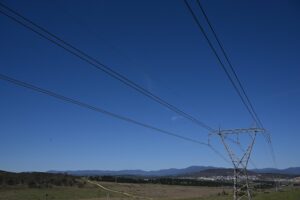Barnett spoils his own solar party
How to spoil a solar party. On the very day that Western Australia could lay claim to being a leader in solar energy, with the opening of the country’s first utility scale solar farm at Geraldton, Premier Colin Barnett declared his opposition to the renewable energy target, a theme enthusiastically taken up at the opening by the nominal energy minister Peter Collier.
Barnett urged the government to “drop” the LRET, and then claimed such a move would not mean less renewable energy. Absolute bollocks. WA has the opportunity to establish its lead as the nation’s solar state, it has better solar resources and higher electricity prices – and solar PV could soon be deployed without the need for additional subsidies. First Solar, which built the 10MW Greenough River plant, says this could happen by 2016 as the balance of system costs come down. Others that RenewEconomy has spoken to during its visit to WA say it could happen even earlier. But, take away the renewable energy target, and those metrics don’t work any more. It will mean less renewable energy – less solar, and less wind.
So, what is it with coalition state governments? Well, that’s easily explained because WA has some things in common with Queensland and NSW – it owns the utilities whose business models are threatened by renewables. But how to explain the regional media? Barnett’s rant against the RET, including some doomsday predictions from Alinta and Horizon Energy, earned a prominent position in the local daily, The West Australian. The opening of the country’s first large scale solar farm on its home soil earned a brief.
Don’t count on bipartisan support for the LRET
Now that the conservative premiers of Queensland, NSW, Victoria and WA have lined up against the LRET, the question really has to be asked about whether this is bipartisan policy or not. The federal coalition says it is, and it is widely assumed to be the case. But some industry executives who have discussed the policy in private, particularly with energy spokesman Ian Macfarlane, are not so sure about the Coalition’s commitment to the 41,000GWh fixed target, the subject of the debate in the current LRET review.
Consider this: the common theme among the Coalition state and federal parties is that they do not support both carbon price and an LRET. Which begs the question of what happens if an elected Abbott government was unable to repeal the carbon tax, as many predict. The answer should be obvious – they will seek to dilute the LRET. Macfarlane has form on this matter because he refused to extend the original MRET when he was energy minister, bringing a sudden halt to the wind energy industry in Australia. And he still doesn’t think much of wind and solar. This must be why the renewables industry is so keen for the Climate Change Authority to recommend the LRET review occur every four years rather than every two years.
Don’t worry about the facts
One thing is certain, facts are not allowed to get in the way of Coalition policy makers. Tony Abbott’s latest intervention in the power price debate was made to look absurd this week when a pensioner’s power bill he brandished as proof of the impact of the carbon price revealed instead a doubling of consumption. Even The West Australian wrote about that story, and Abbott’s embarrassment. Well, the pensioner did come from WA.
Renewable targets should go up, not down
But what does one of the world’s leading economies do when it looks like it will overshoot a renewable energy target? Why, it increases the target, of course. Germany’s environment minister Peter Altmaier, appointed a few months ago because his predecessor was considered too “green”, signalled this week that Germany will lift its renewable target to 40 per cent by 2020, up from its previous target of 35 per cent, because it is clear that the lower target will be easily met. California, as we have reported, took a similar step. China is constantly revising upwards its solar and wind energy targets.
In the case of Germany, the government is now very confident that renewables will fill the gap created by its decision to shut all nuclear plants by 2022. Altmaier, also appointed because he can take a more “practical” approach, now has to implement policies that enables this transition to occur in a seamless manner. That means winding back subsidies for renewables as their costs fall, focusing on storage capacity, and introducing other measures to ensure that enough gas generation remains online to support the grid.
The wind
An example of how the face of the renewables industry can be transformed (for the worse) by a change in government is in Victoria. One revealing statistic that came across our desk this week was the amount of wind energy approved in the state, firstly by the Labor state government: 3,431MW. The amount of electricity approved by the current coalition government (elected late 2010). 6 MW.
Little wonder that wind energy advocates have sought to counter-act the tactics of the vocal anti-wind coalition, and begun to form their own public alliances. The Victorian Wind Alliance that was created this week already boasts more members than the anti-wind groups.
Frustratingly, such initiatives came too late to save the likes of RPG, the country’s largest maker of wind turbine towers, which collapsed this week, partly because of the void that has been created in the wind industry by uncertainty over the LRET. The company is now in the hands of receivers, Ferrier Hodgson, ironically co-founded by one of the most prominent anti-wind activists, rural land owner Tony Hodgson.








